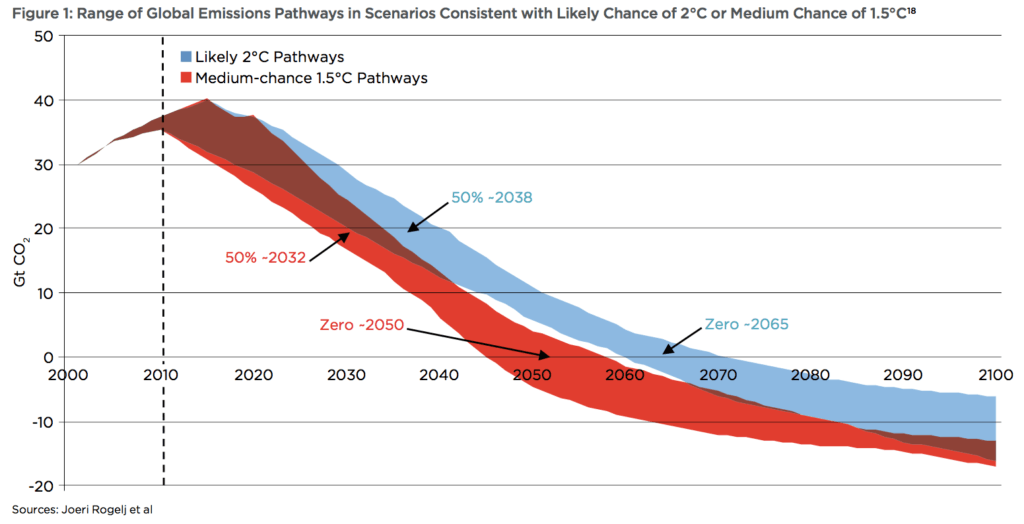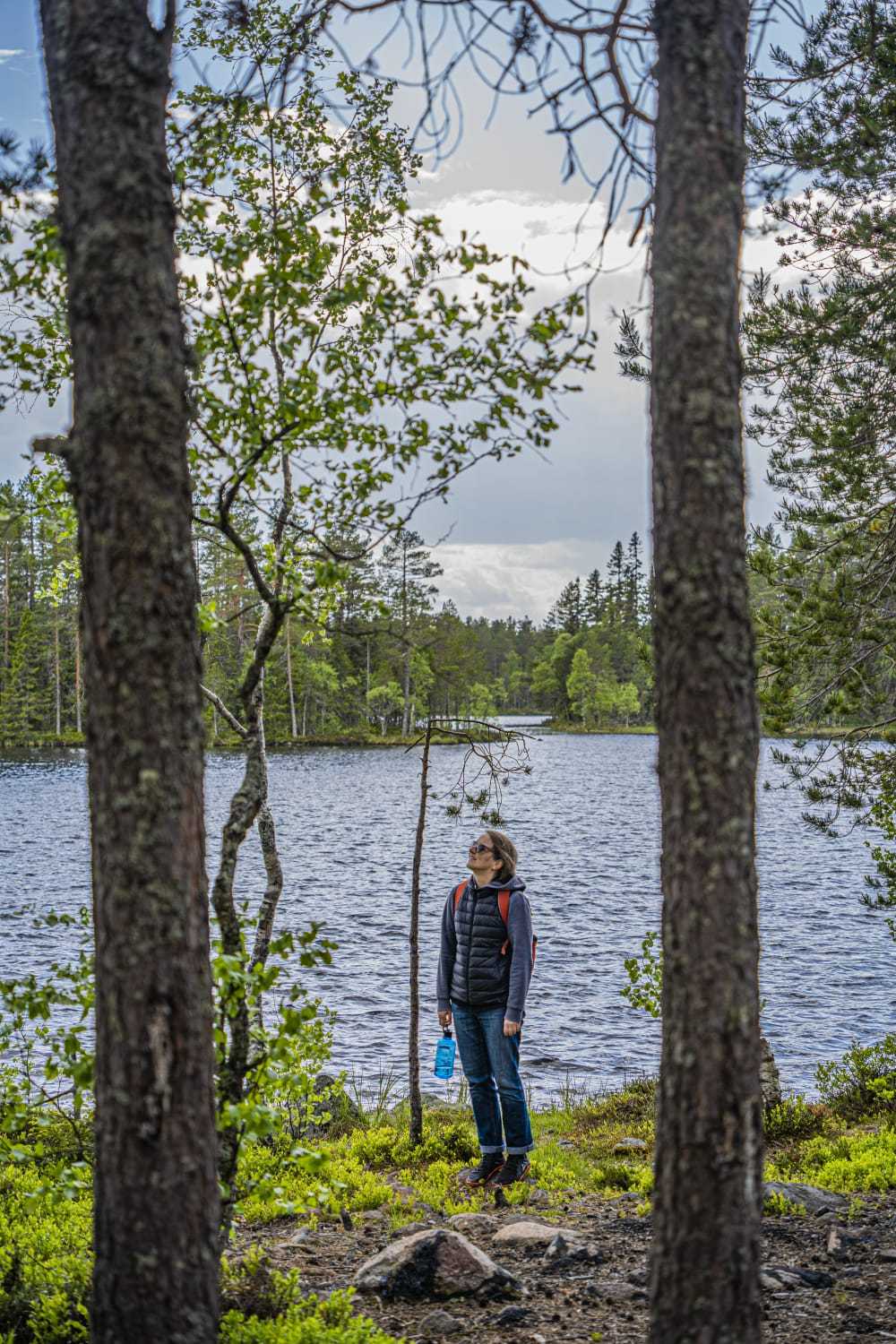
How long do we have to limit the climate crisis: 18 months or 11 years?
“How did it get so late so soon?” ― Dr. Seuss
Is there such a thing as a climate deadline? Do we have 11 years to solve or limit the climate crisis, or just 18 months? Where do these numbers come from, and what do they mean? Below we break down the story behind the 11 years/18 months figures that have been cited by media outlets, experts and politicians alike over the last few months.
Where does “11 years” come from?
This was taken from the Intergovernmental Panel on Climate Change (IPCC) Special Report “on the impacts of global warming of 1.5C degrees above pre-industrial and related greenhouse gas emissions pathways, in the context of strengthening the global response to the threat of climate change, sustainable development, and efforts to eradicate poverty.”
What is the IPCC?
The IPCC is a United Nations body founded in 1988 which evaluates climate change science and synthesises it into major assessment reports every 5–7 years. The report published in October 2018 is the latest climate assessment—the result of an invitation contained in the Decision of the 21st Conference of Parties of the United Nations Framework Convention on Climate Change (also known as COP21) to adopt the Paris Agreement.
In other words: After the COP21 in Paris (December 2015), the IPCC experts had about 2 years to prepare a special report on the impacts of global warming of 1.5 degrees Celsius.
The 11 years had been extracted from this paragraph in the summary for policymakers:
“Human activities are estimated to have caused approximately 1.0°C of global warming 5 above pre-industrial levels, with a likely range of 0.8°C to 1.2°C. Global warming is likely to reach 1.5°C between 2030 and 2052 if it continues to increase at the current rate.”
Because the report was made public in October 2018, some estimated that we have 12 years to 2030. Others realised that with 2018 almost over, it was more like 11 years. Media outlets picked up the 11 years (“11 years to save the planet” or “11 years to limit climate change catastrophe”) and used it for almost a year. Most of them still do, although it’s of course less than 11 years now.
Wait, what happened at COP21?
COP (Conference of Parties) are UN conferences that attract tens of thousands of participants from all over the world—official delegates from governments, intergovernmental organisations, UN agencies, NGOs and civil society—and discuss global issues with a global participation.
On December 12, 2015, at the end of COP21 (the 21st Conference of Parties of the United Nations Framework Convention on Climate Change), 195 nations signed an agreement to combat climate change and to strengthen their ability to deal with the impacts of climate change. The main aim of the agreement was to keep global temperatures below 2 degrees Celsius and to limit temperature increase to 1.5 degrees Celsius above pre-industrial levels.
This was the first time in over 20 years of UN climate negotiations (all those COP conferences and summits and other similar international gatherings) that so many countries achieved a legally binding and universal agreement on climate action.
Quick note 👉 “The Paris agreement is legally binding in forcing governments to accept and cater for the 2C limit. But the commitments on curbing greenhouse gas emissions in line with that goal are not legally binding.” (The Guardian)
Overall it was considered an ambitious agreement, a step forward, but for many activists and experts it remained controversial for not aiming high enough given the gravity of the situation.
Further reading 👉 This graphic explaining why 2 degrees of global warming will be way worse than 1.5

What’s going to happen in 11 years?
In 11 years (for accuracy: 10 years and 4 months from August 2019) “we should be halfway to global net-zero GHG emissions” in order to avoid increasingly dire impacts of the climate and ecological crises. Climate scientist Peter Kalmus points out that “today’s impacts are effectively due to emissions from ~ decades ago,” but emissions keep rising exponentially.
In other words, we spotted the problem but failed to act fast enough to fix it, and the window of opportunity is closing: which brings us to the “18 months.”
What’s with the 18 months then?
The conversation about the 18 months became mainstream earlier this summer when an article with an ominous title (“Climate change: 12 years to save the planet? Make that 18 months”) was published on the BBC. Startling for many, this was far from breaking news—the source for the 18 months comes from the same IPCC Special Report referenced above.
The report also mentioned that “global emissions of carbon dioxide must peak by 2020 to keep the planet below 1.5C,” and would have to be cut by 45% by 2030. But as the BBC states: “current plans are nowhere near strong enough to keep temperatures below the so-called safe limit.” Signatory countries have promised to improve their carbon-cutting plans by the end of next year, but “right now, we are heading towards 3C of heating by 2100 not 1.5.” Overall emissions haven’t gone down.
Back in 2017, climate scientist Hans Joachim Schellnhuber said: “The climate math is brutally clear: While the world can’t be healed within the next few years, it may be fatally wounded by negligence until 2020.”
The next 18 months are considered critical, most likely the make-or-break months in dealing with the climate crisis and other environmental challenges exacerbated by it. To meet the climate targets, the policies meant to enable the 45% cuts in carbon will have to be ready by the end of 2020. Some say that ever since the global climate agreement was signed in Paris, negotiators have been consumed with arguing about the rulebook for the pact instead of focusing on the task at hand.
Known as a keen conservationist, Prince Charles, quoted in the same BBC article, said: “I am firmly of the view that the next 18 months will decide our ability to keep climate change to survivable levels and to restore nature to the equilibrium we need for our survival.” He’s steering the conversation into other ecological crises (depletion of species, ocean pollution, etc.) which must not be overlooked.

What’s going to happen next?
In the coming months the public will find out more about the state of the climate, national carbon targets, and (new?) plans to limit climate breakdown, during several planned climate summits and conferences. How much have countries worked towards meeting the Paris agreement targets? Will climate leadership finally fully manifest itself next year?
Since we seem to like timelines, here are some important dates for global climate decisions:
- 2019, September 23 | Climate Action Summit (New York, USA) aiming to “inject momentum in ‘race to the top’ among countries, companies, cities and civil society that is needed to achieve the objectives of the Paris Agreement and the Sustainable Development Goals.” Countries coming to the summit should present their national carbon cutting plans.
- 2019, December | COP 25 (Conference of the Parties – UN Conference) in Santiago, Chile
- End of 2020 | COP 26 Glasgow, UK
Is time on our side?
During a talk earlier this year, Bill McKibben made a good a point about bad timing. If we had started acting on climate 30-40 years ago—when scientists first presented decision makers with evidence of the anthropogenic rapid changes in the climate of the planet—small steps to help humanity adapt to changes and tackle the crisis would have been enough. But because of the premeditated stalling of action on climate, we now have to take giant leaps in a matter of years (or months!) to deal with it.
Are we taking giant leaps? Not according to the global carbon emissions from energy, which last year hit a record high.
2019: A record-breaking year
July 2019 was the hottest month in human history, with record temperatures all over the world. Greenland lost 12.5 billion tons of ice in just one day. California experienced its deadliest wildfires ever. High-latitude wildfires had an ‘unprecedented’ season, while parts of Alaska had no sea ice for the first time ever. Permafrost is thawing 70 years earlier than predicted. Let’s not forget increasingly severe floods, droughts, hurricanes, typhoons. And this May, for the first time since humans have existed on Earth, carbon dioxide in the atmosphere exceeded 415 parts per million, reaching 415.26 parts per million.
The latest report from the IPCC released this August—on climate change and land—is yet another “blueprint for action”. But will decision makers pay attention?
This July was the hottest month ever recorded. The climate emergency is intensifying month by month, day by day. Every bit of warming matters. The only response is #ClimateAction NOW. pic.twitter.com/kL56kCvOXy
— António Guterres (@antonioguterres) August 16, 2019
Further reading 👉 Here are seven ways of understanding the IPCC’s newest climate warning.
The worsening climatic impacts and dire scientific warnings are making the crisis less of a distant occurrence, and more of a visible, daily reality. Public mobilisation is growing, more people are taking individual action, and climate denialism is slowly falling apart— but compelling political leadership on climate is essential in all climate action scenarios. It needs to be front and centre of a transformational change in all aspects of society.
An article that says we shouldn't have deadlines – as it might people off. 🙄
— Professor Mark Maslin 𝕏 🙄 (@ProfMarkMaslin) July 26, 2019
Let us be serious – we are in a #ClimateCrisis 🌡the world has to get to #ZeroCarbonEmissions by 2050. Deadlines and Targets are essential – even if we miss them at least we are trying to hit them💡 https://t.co/2llCmXv199
The scientific consensus that humans are causing global warming is likely to have passed 99%, according to studies quoted in The Guardian. We can still debate the dangers of “deadline rhetoric,” but the sooner we act towards system change, lowering emissions, and speeding up the healing process, the better.
The best time to act on climate was decades ago. The second best time is now.
What can I do?
There’s a lot we can do as individuals. Here are just some of the things we’ve already discussed on our blog:
- Check out these climate experts’ advice
- Eat a planet-friendly diet
- Divest your money from fossil fuels
- Fly less or stop flying
- Follow a climate scientist and talk about the climate crisis to those around you
- Join the Global Climate Strike this September
- Be mindful
- Don’t lose hope
Further reading on the climate crisis timeline:
Losing Earth: A Recent History by Nathaniel Rich
Falter: Has the Human Game Begun to Play Itself Out? by Bill McKibben (especially the chapter about the Exxon files)
The Uninhabitable Earth: Life After Warming by David Wallace-Wells (an exploration of how the world could look if we fail to curb carbon emissions)
What do you think?
If you have a different understanding of the climate timelines and the debates around them, share with us in the comments!
Featured image via Shutterstock
Earth.fm is a completely free streaming service of 1000+ nature sounds from around the world, offering natural soundscapes and guided meditations for people who wish to listen to nature, relax, and become more connected. Launched in 2022, Earth.fm is a non-profit and a 1% for the Planet Environmental Partner.
Check out our recordings of nature ambience from sound recordists and artists spanning the globe, our thematic playlists of immersive soundscapes and our Wind Is the Original Radio podcast.
You can join the Earth.fm family by signing up for our newsletter of weekly inspiration for your precious ears, or become a member to enjoy the extra Earth.fm features and goodies and support us on our mission.
Subscription fees contribute to growing our library of authentic nature sounds, research into topics like noise pollution and the connection between nature and mental wellbeing, as well as funding grants that support emerging nature sound recordists from underprivileged communities.

